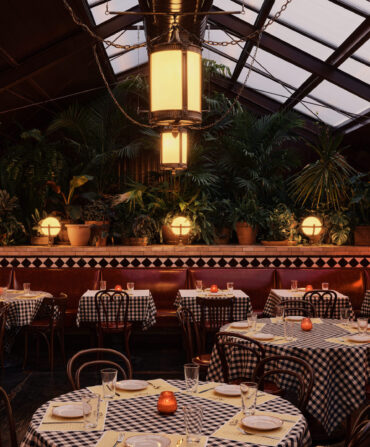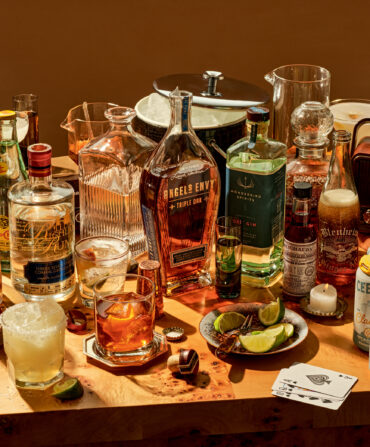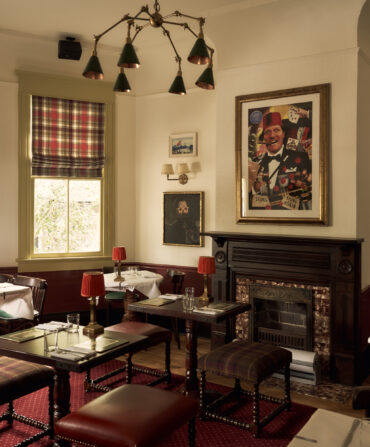Food & Drink
Emeril Lagasse: The Big E
Before the TV shows, the cookware, “Bam!,” and the rest, Emeril Lagasse was a young chef taking over the venerable Commander’s Palace, the launching pad for a career that would change the food world forever. Now, with his first new New Orleans spot in nearly two decades, he’s back to doing what he really loves

Photo: Jeff Lipsky
If there’s a true state of nature for the species Chefes americanus, the common American chef, it’s not in front of the stove, not dreaming up the next great recipe, not even on television, but nervously awaiting the inspections that say he or she can finally open the doors of a new restaurant. And that is where Emeril Lagasse—a most uncommon American chef—finds himself this afternoon in September, a week before the doors are set to open at Meril, his first new New Orleans restaurant in eighteen years. “Right now, we’re waiting on our hands and knees and fingers and toes because tomorrow is the big inspection,” Lagasse says, smoothing back his hair worriedly with one bearlike hand. “Maybe the lady won’t be in a good mood and then we get delayed.” It goes to show: You can be the most famous cook in the world, the most successful exporter of Louisiana culture since Louis Armstrong and Fats Domino, a name all but synonymous with an entire American city, no last name needed, and yet…New Orleans bureaucracy will still strike fear in your heart.
We’re in the business headquarters known as Emeril’s Homebase, on St. Charles Avenue, just a few blocks from both the new restaurant and Lagasse’s flagship, Emeril’s New Orleans. A large neon cursive E hangs in the window, a portrait of the man himself in the lobby. There are two floors of offices here, devoted to all things Emeril—or at least those things left after Martha Stewart Living Omnimedia acquired the Emeril brand of spices, cookware, and other licenses for $50 million in 2008, leaving Lagasse in charge of his restaurants and the expansively charitable Emeril Lagasse Foundation. In a warehouse space toward the back of the building, there are stacks of boxes marked “BAM.” They turn out to contain T-shirts, but for a while I want to believe they are filled with pure distillations of laissez les bons temps rouler, to be opened as necessary.
For all its corporate reach, Homebase is surprisingly, well, homey. Many of Lagasse’s employees have been with him for decades now. In the test kitchen where Lagasse is pacing preoccupiedly, his brother, Mark, who handles maintenance at his New Orleans restaurants, stands on a chair, trying to coax the air-conditioning to life. Their father, known as Mr. John, wakes at 6:00 a.m. to open the doors at Homebase and Emeril’s New Orleans. Meril’s young chef, Will Avelar, and the company’s culinary director, Chris Wilson, are in the test kitchen, working on a handful of dishes for the new restaurant. There are grease traps to look after. Waiters to train. Menus to be printed.

Photo: Jeff Lipsky
“It’s a new baby,” says Lagasse, who has been down this road at least a dozen times before. “So, day one will be different than week one. And week one will be different than month one, because it really is like having a baby. It’s like nurturing something that comes alive.”
“Emeril is pretty good at TV,” says Wilson, who as a member of the team in various capacities for twenty-six years may have earned the right to some understatement. “But what really gets him excited is opening restaurants.”
Lagasse is fifty-seven, but he’s been with us so long, his influence has been so great, and the peak of his extraordinary fame is far enough in the past that you could be forgiven for thinking he’s older. His passage to culinary elder statesman status has been simultaneously slow and sudden. Bon Appétit recently filmed a video for its website in which Lagasse roamed the halls of the magazine’s headquarters, sneaking up behind people and shouting, “Bam!” It was inspired, self-aware, and also sort of melancholic: Emeril Live, his prime-time variety cooking show, has barely been off the air six years but, thanks in part to the morass of travel and competition shows that food television has become, it feels like another epoch. Meanwhile, a generation’s worth of chefs has walked through the career doors Lagasse opened. His influence, on both what chefs serve and how they live, is so pervasive that reasonable people could disagree about whether it’s all been to the good. He’s there equally in Anthony Bourdain and in Guy Fieri; in the knockout flavors of a Momofuku pork bun; and in every Jack Daniel’s–glazed steak served at T.G.I. Fridays.
So, why him? Of all the ambitious young chefs on the cusp of the food revolution that’s taken place over the past two decades, why did this one from New Orleans, by way of Fall River, Massachusetts, change the world of dining?
He arrived in the Crescent City at age twenty-six, to take over the kitchen at Commander’s Palace, the great blue ship of a restaurant moored on a corner at the center of the Garden District. Ella Brennan, the matriarch of the Brennan restaurant family, which owns Commander’s Palace, had gotten ahold of his résumé, along with a recommendation from Larry Forgione, one of the fathers of the new American cuisine that was starting to bubble on stoves across the country. For months, she and Lagasse conducted a professional flirtation by phone. “She would call and ask, ‘How are you on wine?’ Or, ‘What are you cooking tonight?’” Lagasse recalls. “Until finally it was time to come down for an actual interview.”
His job was to replace Paul Prudhomme, the man who had more or less invented what Americans would come to think of as Creole-Cajun food in his time behind the Commander’s Palace stove, including one technique—blackening—that was so successful it has been blamed for nearly wiping out the state’s redfish. But, you know: no pressure.
Lagasse fell in love with the city. But he also got a crash course in how claustrophobic its traditions could be. “In the beginning, there were a lot of things that were ingrained, not only in the customers but in the staff and the family,” he says. “There really was no window for me to do any of my food. It was like, How am I going to make an impact here?” How narrow was the window? When Lagasse first tried to put a dish as innocuous as rack of lamb on the menu, he was told, “New Orleanians don’t really eat lamb.” Even local fish that weren’t redfish or speckled trout—triggerfish, mahimahi—were novelties, never mind such unspeakably exotic species as salmon from the Pacific Northwest. Lagasse spent his days off on fishing boats or driving around the surrounding countryside, hunting down new products: strawberries from Ponchatoula, rice from Crowley, white tuna from the Gulf. One by one, he managed to slip these onto the menu, first as specials, later, in many cases, as staples.
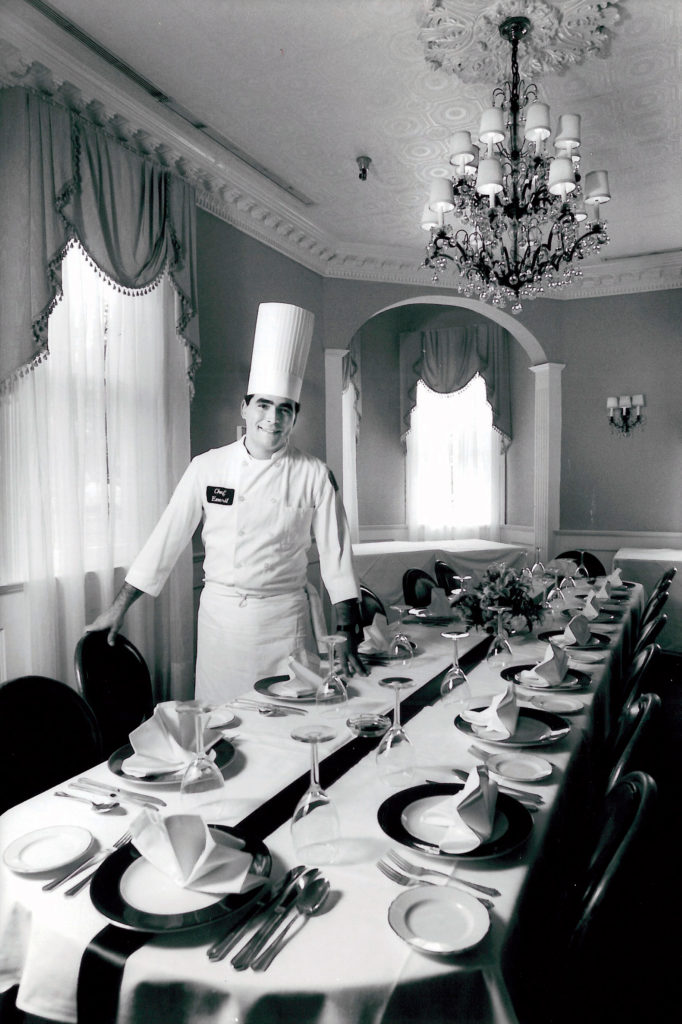
Photo: Ellis Lucia, The Times-Picayune
Lagasse at Commander’s Palace in 1988.
“I said, ‘Listen, I can make the food better. I don’t know why we’re using frozen artichokes. Why don’t we use fresh artichokes? I don’t know why we’re buying frozen pecan pies. Why don’t we make our own pecan pies?’” he says.
In time, Brennan went from gatekeeper to collaborator: The two would meet each Saturday afternoon to leaf through cookbooks, in search of inspiration. “We’d say, ‘Wow, if we could just New-Orleanian-ize this! If we could Commander’s-ize this, it would be really cool,’” Lagasse says.
They might as well have said, “Emerilize this.” By the time Lagasse left Commander’s Palace to set out on his own, what that meant was clear: great product, big portions, intense, hypersavory flavors, and a freewheeling range of inspiration. Emeril’s, which opened in 1990, threw open the window wide on what a New Orleans restaurant could look like (sleek, urban, and open, instead of fusty and cloistered), where a New Orleans restaurant could be located (in the then moribund Warehouse District), and what a New Orleans restaurant could serve. Lagasse laid claim to cuisines well beyond Louisiana’s borders: the South (by which New Orleanians mean north of I-10), the Southwest, Italy, Vietnam, whose immigrants were already beginning to add their influence to Louisiana’s Creole stew. Any place that offered big flavors became fair game for annexation by Bam Nation.
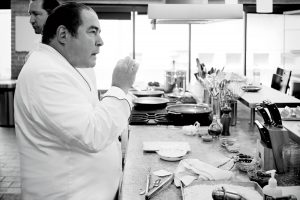
Photo: Jeff Lipsky
Working the room
Lagasse leads his team in the test kitchen at Emeril’s Homebase in New Orleans.
One signature dish at Emeril’s was a double-cut pork chop, the height and heft of a Big Bertha golf club, glazed with tamarind, covered in a green mole, and served alongside sweet potatoes that had been roasted in olive oil, salt, brown sugar, and cinnamon. Still served in the restaurant, it looks like a towering wedge of ice cream cake. Another, also still a staple, was Gulf fish encased in a crust of andouille sausage—an almost punk-rock rejection of fish as the “light” option, even by the standards of a city accustomed to heaping meunière sauce and lump crab on anything that swims.
There was a learning curve on both sides of the food bar that separated the dining room from the open kitchen. Lagasse was a zealous teacher. One day, he dragged a whole Costa Rican palm tree to the predinner staff meeting, to show cooks and servers where hearts of palm came from. Standing by the counter during service, remembers Anne Kearney, an early Emeril’s cook who now owns and operates a restaurant in Dayton, Ohio, Lagasse demonstrated the kind of enthusiastic instruction to which millions of TV viewers would soon grow accustomed. “He would sit there saying, ‘Are you familiar with this? Have you ever had an artichoke? Let me get you to try this,’” Kearney says. “He made you feel like part of things. And you took that back to whatever town you came from.”
It mattered that he’d come from someplace else, even that he was a Yankee. “It’s like he was a tourist who had fallen in love with all the things about New Orleans that every tourist falls in love with,” says the director of the Southern Foodways Alliance (and Garden & Gun contributor), John T. Edge. “He was able to channel the feeling of that frenzy of discovery.” If Prudhomme was sitting back and saying, in effect, “Look at what we have down here,” Emeril was rushing giddily toward you: “Look at what I’ve found.” In the same way that the best writing about New York has always come from writers born below the Mason-Dixon Line, it took a son of Fall River to create what his first cookbook succinctly labeled New New Orleans Cooking.
And then, of course, there was TV. Perhaps Emeril was destined to take over the airwaves, one way or the other, but his specific path demonstrated the blend of intuition and charisma that made it so: One night during Jazz Fest, in the late eighties, four friends came into a packed and overflowing Commander’s Palace. Among them was Shep Gordon, the gifted and imaginative manager for Alice Cooper, among others, who was also an obsessive amateur foodie. The men were in a bad mood and the wait wasn’t helping, until the young chef suddenly materialized, marched them past the crowd to a prime table, and began sending out food and champagne.
 “Who does he think you are?” Gordon’s companions whispered.
“Who does he think you are?” Gordon’s companions whispered.
“I have no idea,” said Gordon, who had no intention of correcting whatever misconception Lagasse may have had.
It turned out that Lagasse had a habit of picking out customers who seemed receptive and “taking them on a ride.”
“Shep kept poking his head into the kitchen, checking out what was going on,” Lagasse remembers. “I can read people fairly well. I’m a good listener. And when I see somebody in the dining room that is really into what they’re doing, I get really excited.”
This time, he had chosen the right table to wine, dine, and eventually send off to Tipitina’s with go cups of expensive cognac. Later, when Gordon began advising chefs such as Roger Vergé and Wolfgang Puck, essentially creating the category of celebrity chef, he insisted on including the New Orleans chef who had been so gracious to him. Helping to bring Lagasse to the nascent Food Network, he negotiated a prophetic deal: On The Essence of Emeril, which debuted in 1994, he and Lagasse would get advertising time for their new similarly named spice blends.
“I felt like I owed it to him, for being so nice to me,” Gordon says. “I thought I could carry him along. It turned out he was leader of the pack.”
Lagasse’s instinct for connecting with the curious, it soon became clear, came right through the television screen. The Emeril of The Essence of Emeril was fun, populist, and also distinctly macho, at a time when home cooking still held a stigma for many men.
“He made cooking sexy,” says Gail Simmons, of Top Chef and Food & Wine magazine. “He was a manly man: ‘Throw on some whiskey! Kick it up a notch!’”
Not being from Manhattan or Europe helped: On close listening, his accent is as New England as chowder and fall foliage, but it belongs to that mélange of immigrant voices—Irish, Italian, Polish, Russian—heard in working-class neighborhoods up and down the Eastern Seaboard and around the Gulf, a mush-mouthed bray that can make the French Quarter seem like the lowest precinct of the Bronx. (The first time I saw Lagasse, I assumed he was from my neck of the woods, in Italian/Jewish Brooklyn.) By 1997, Emeril Live, with its live music, raucous audiences, and celebrity guests, was airing five nights a week. The behind-the-scenes struggles on NBC’s short-lived sitcom Emeril—starring Emeril and about, well, Emeril—were high profile enough to be the subject of a Saturday Night Live parody. (Fifteen years later, the show, much of which is watchable on YouTube, proves to be no better but also not much worse than much of what else was on network TV in 2001.)
Meanwhile the restaurants proliferated: Lagasse was among the first wave of chefs to see the possibilities and reap the financial rewards of Las Vegas’s transformation from Sin City to family destination. He now owns four restaurants there, including Emeril’s New Orleans Fish House at the MGM Grand and Lagasse’s Stadium, a mammoth sports bar at the Palazzo. In Orlando, Florida, are Emeril’s Orlando and Emeril’s Tchoup Chop, while a casino in Pennsylvania houses yet three more outposts of Emerilania.
Perhaps lost in all that was the fact that, night after night, Lagasse was still teaching a generation of future chefs how to cook. When Lagasse began appearing on Top Chef as a guest judge, Simmons was taken aback by the reverence with which so many of the young chef-contestants treated him. “I had never thought of him as a chefy chef, so I was surprised to see the respect and awe all these ‘serious’ young chefs had for him,” she says. They might have had some version of the experience the Los Angeles chef Roy Choi describes in his memoir, L.A. Son: In his mid-twenties, struggling with various addictions, he woke up one morning on a friend’s couch, “half asleep, half dead, half drunk, half high, half assed.” On television was “a dude cooking in a checkerboard-tiled kitchen.” As Choi dozed back off, he had a vision. Emeril Lagasse was talking to him.
His eyes were looking straight at me like f***ing Mona Lisa’s…. And he was shoving oregano and basil under my nose. For one long second, I felt the herbs tickling my nose; I smelled the stew bubbling in the pot. It was exhilarating. Captivating. And bam, just like that, I knew. This was my destiny.
If, despite all that, Lagasse is still often written off as more celebrity than chef, it is in part the inevitable trade-off of having a “Stadium” among your restaurants. It’s also true that, even after two decades of celebrity chefdom, we still tend to distrust and punish great fame and financial success among our cooks. Not that it seems to cause Lagasse undue concern.
“I get up in the morning and do what I need to do, whether it’s on TV or in the restaurant,” he says. “I never try to be anything other than who I am.”
There have been some steps he seems to have second thoughts about. Martha Stewart Living Omnimedia has recently changed hands, and Lagasse is unsure of what will happen to his deal there.
“I’m not really a corporate guy,” he says. “I went to Martha Stewart because I didn’t have the financial resources to grow this thing the way it needed to be grown. And I was being stirred by people that convinced me it would be a good thing. I have no regrets for anything I’ve done, but if I were doing life again? I probably wouldn’t have listened to as many people and would have stuck with my gut instead.”
His gut has had to be his guide for much of the six years since he lost his mega TV platform. He admits that there was a long curve to accepting the cancellation of Emeril Live after eleven seasons. “It was a very empty feeling for me: ‘You mean I’m not going to wake up and shoot two shows a day?’” he says. “I sort of had to back up a little bit and analyze me, analyze my company, and analyze what I was doing. I decided I was only going to do what I wanted to do.”
What that has meant has been a smaller, more personal television presence. He appears as a sage adviser and adjudicator on Top Chef; as a guide to his other adopted home state on Emeril’s Florida (Lagasse lives near Destin with his third wife and their children); and most recently as the star of Amazon’s charmingly casual Eat the World with Emeril Lagasse, in which he travels to far-flung places with fellow chefs: Shanghai with Mario Batali (the man who has followed in Lagasse’s media footsteps most closely), South Korea with Danny Bowien, Spain with José Andrés.
Ingredients and techniques from his travels have been finding their way back home and onto the menu at Emeril’s—from Italy, colatura di alici, a fermented-anchovy sauce that gooses up a plate of pasta with escargots; from Japan, bronzed yakitori of Louisiana quail—though there are limits. Lagasse recently spent time with the legendary molecular gastronomist Ferran Adrià, but you should not expect to see étouffée foam or other trickery on an Emeril menu anytime soon. “Are you kidding me?” he says. “My people don’t want that.”
In many ways, the flagship restaurant is an amber-preserved artifact of nineties dining and an over-the-top Bamsplosion. Witness a tasty but unruly “appetizer” of lamb neck nachos that could feed the Saints’ offensive line. At the same time, it is capable of being a nimble modern Southern restaurant. Its wine list ranks among the deepest and most adventurous in town. Lagasse’s fetish for sourcing products remains in full effect. The flour for one of the several rolls served at Emeril’s comes from a tiny local miller and baker named Bellegarde; the pasta from another microproducer, Esses Foods. Even at NOLA, the most commercial, and least deft, of his New Orleans restaurants, the lunch bartender informed me that the soup of the day was pork and greens because “Chef got in a beautiful Chappapeela pig this week and is doing some amazing things.” All of this, one imagines, is more than what’s strictly demanded by those seeking lamb nachos from a famous television chef.
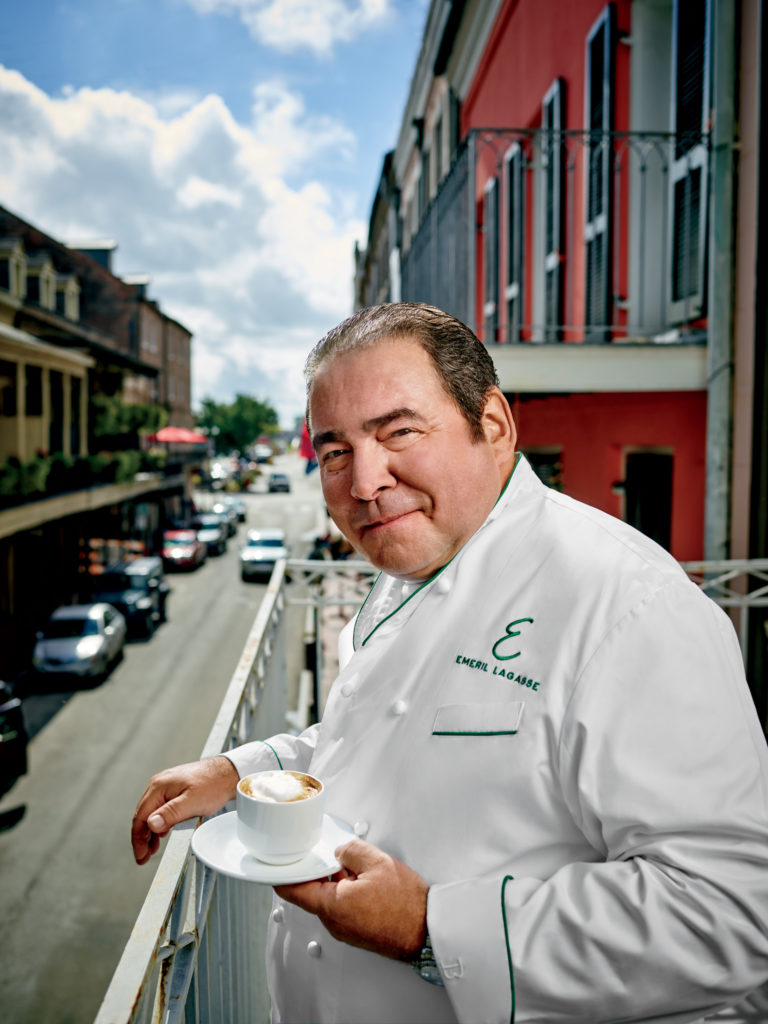
Photo: Jeff Lipsky
Commanding View
At NOLA, overlooking the French Quarter.
Lagasse is aware that the dishes he once invented to break the straitjacket of New Orleans cooking have now become the classics a new generation of chefs will chafe against. He gives his kitchens latitude to invent, within reason. “All of my chefs know the box,” he says. “First of all, we’re not using customers as guinea pigs. Don’t be trying crazy shit like trout with blueberry sauce. Then: Solid ingredients. Solid cooking techniques. Price-value relationship. And it has to taste good or forget it. Don’t even think about it.”
The last time he opened a restaurant in the city that made him famous was in 1998, when he renovated and reopened Delmonico’s as Emeril’s Delmonico. Shortly after, his relationship with New Orleans briefly became strained as it took him many months to reopen, or even visit the city, after Hurricane Katrina. “That Lagasse, one of popular culture’s great media masters, took a pass on the chance to put his own mega-celebrity to good use at such an unprecedented moment is just one of many post-Katrina mysteries,” Times-Picayune food critic Brett Anderson wrote at the time. (Anderson remains puzzled but points out that Lagasse has made tremendous amends through the work of the Emeril Lagasse Foundation.)
Since Katrina, the influx of people from other parts of America and the world has stood New Orleans food culture on its head. In 2016, the hottest place in the town whose tastes were once too narrow for rack of lamb is Shaya, an Israeli restaurant that’s won a host of national accolades, including the James Beard Award for Best New Restaurant. (Here, Lagasse’s competitive spirit flares. “Come on,” he says. “I like [chef] Alon Shaya. I like his food. But as far as saying it’s the number one restaurant in the country or whatever, come on. That’s just a lot of journalists sitting around a table.”)
The menu at Meril, which is named after one of Lagasse’s daughters, reflects some of the new globalism of its city, expanding even on the reach of its older sibling down the street. “It’s going to be clean, simple, good food,” Lagasse says. On the counter in the Homebase test kitchen, Chef Avelar lays out plates of fish tacos and Korean barbecue short ribs. There are cups of potato salad topped with caviar and a hot, moist biscuit slathered with foie gras butter. “I didn’t say light,” Lagasse says, with the semblance of a wink.
It is not, he says, a “New Orleans menu.” But he’s got that wrong. It’s an Emeril Lagasse menu.
And now, and maybe forever, those things are one and the same.


